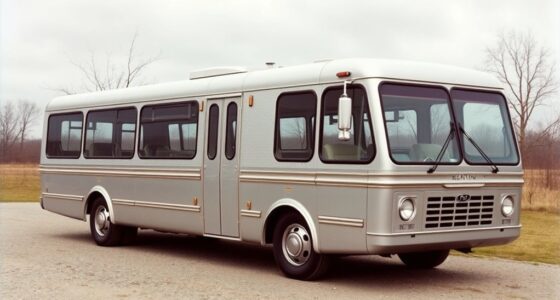The VW Bus started as a practical, affordable vehicle, becoming an icon of 1960s counterculture and symbolizing peace and freedom. Over time, environmental concerns led to modernization efforts, introducing electric versions that keep its classic look—rounded shape and large windows—while reducing emissions. Today, it’s a pioneer blending nostalgia with sustainability. If you want to see how this iconic vehicle has evolved from a hippie symbol to an eco-friendly innovator, keep exploring the story.
Key Takeaways
- The VW Bus originated as an affordable, practical vehicle and became a symbol of 1960s counterculture and peace movements.
- Its distinctive retro design and cultural significance cemented its status as an iconic hippie symbol.
- Environmental concerns in later years prompted efforts to modernize the model with cleaner, more efficient technology.
- Electric versions of the VW Bus maintain its vintage aesthetics while offering zero-emission, sustainable transportation.
- The evolution reflects a shift from cultural icon to eco-friendly pioneer, blending nostalgia with innovative, green technology.
Have you ever wondered how the iconic VW Bus evolved from a simple commercial vehicle into a symbol of counterculture and freedom? In its early days, the Volkswagen Type 2, commonly known as the VW Bus, was designed with practicality and affordability in mind. Its retro design, characterized by rounded edges, large windows, and a boxy shape, made it instantly recognizable and beloved. This distinctive look not only set it apart from other vehicles but also contributed to its status as a cultural icon. Over time, its aesthetic appeal helped it resonate with the youth movement of the 1960s, symbolizing peace, freedom, and nonconformity. But beyond its looks, the VW Bus also faced scrutiny for its environmental impact. During its peak years, it was known for being relatively inefficient, with modest fuel economy and emissions that weren’t eco-friendly. As environmental awareness grew, this aspect of the vehicle became a concern, prompting efforts to modernize and adapt.
Throughout the decades, the VW Bus remained a nostalgic symbol, but the automotive industry’s shift toward sustainability started to influence its evolution. Manufacturers began rethinking the traditional design and functionality, leading to the development of newer models that aimed to balance retro charm with cleaner technology. Today, that balance is achieved through electric versions of the VW Bus, which pay homage to the original’s iconic style while considerably reducing environmental impact. These modern iterations retain the vintage appeal, with the same rounded shape and large windows, but are powered by electric motors that produce zero emissions. This shift from fossil fuels to electric reflects a broader industry movement toward sustainability, aligning the VW Bus with current environmental standards. The new electric VW Bus aims to preserve its cultural significance while addressing the modern challenges of climate change and pollution.
In essence, the evolution of the VW Bus illustrates a journey from a practical, if not eco-friendly, vehicle into a symbol of environmental responsibility. Its retro design remains a key part of its charm, but now it’s coupled with cutting-edge technology that minimizes environmental impact. You can see this transformation as a reflection of broader societal shifts: embracing nostalgia while actively working toward a greener future. The VW Bus’s transition from hippie icon to electric pioneer exemplifies how tradition and innovation can coexist, ensuring that this legendary vehicle continues to inspire generations to come.
Frequently Asked Questions
What Inspired the Original Design of the VW Bus?
The van inspired origins come from a need for practical, versatile transportation that also evokes a nostalgic design. You can see how the simple, boxy shape and spacious interior were crafted to maximize utility and appeal to adventurous spirits. The nostalgic design reflects a desire for freedom and community, making it a timeless symbol. Its innovative, functional form inspires both practicality and emotional connection in those who admire its classic, iconic look.
How Did the VW Bus Influence Counterculture Movements?
You might think the VW Bus’s influence is just nostalgia, but it’s a powerful symbol of counterculture movement and social activism. Its spacious design fostered community, making it a mobile rallying point. The bus became a symbol of freedom and rebellion, inspiring protests and alternative lifestyles. Its enduring legacy shows how it shaped social values, turning it into an icon that represented resistance, unity, and the desire for change.
What Were the Major Technological Advancements Over the Years?
You see, over the years, the VW bus saw major technological advancements like solar innovations, boosting eco-friendliness and energy efficiency. Safety enhancements also improved crash protection and driver assistance. These upgrades transformed the bus from a simple, iconic vehicle into a more modern, sustainable, and safer mode of transportation, reflecting how innovation continues to shape its legacy while appealing to new generations seeking eco-conscious travel.
How Has the VW Bus Impacted Modern Electric Vehicle Design?
You see, the VW Bus has considerably influenced modern electric vehicle design by inspiring futuristic features and sustainability innovations. Its iconic shape encourages aerodynamic efficiency, while its conversion to electric power highlights eco-friendly technology. You can appreciate how this vehicle’s evolution promotes sustainable transportation, blending nostalgic design with cutting-edge features. This impact pushes manufacturers to prioritize innovation, making electric vehicles more appealing and accessible, ultimately shaping the future of eco-conscious mobility.
Are There Any Limited-Edition VW Bus Models Available Today?
Did you know that only a handful of limited-edition VW bus models exist today? You can find vintage collectibles and custom modifications that make each one unique. These special models often feature exclusive paint jobs, upgraded interiors, or modern tech, appealing to enthusiasts and collectors alike. If you’re interested, keep an eye out at specialty auctions or dedicated VW shows, where these rare buses sometimes appear.
Conclusion
You’ve seen how the VW Bus transformed from a symbol of the hippie movement to an innovative electric pioneer. Did you know over 12 million of these iconic vans were produced worldwide? Their journey reflects not just a cultural shift, but a commitment to sustainability. As you think about their evolution, remember that this beloved vehicle continues to inspire change—showing that even the most legendary icons can adapt and lead the way into the future.






